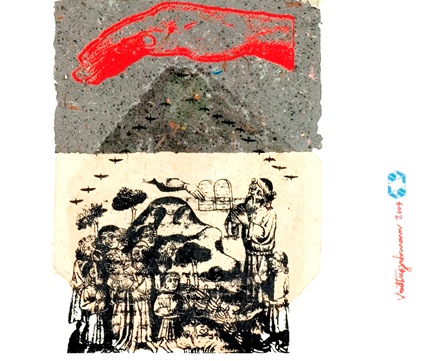Dibaxu: a comparative analysis of Clarisse Nicoïdski's and Juan Gelman's bilingual poetry
DOI:
https://doi.org/10.17851/1982-3053.5.8.89-101Keywords:
Ladino, Poetry, Nicoïdski, GelmanAbstract
This essay reads Argentine poet Juan Gelma's 1994 bilingual Ladino-Castellano book Dibaxu in light of its intertextual relationship with Franco-Bosnian author Clarisse Nicoïdski's work, especially her 1986 bilingual Ladino-English poetry collection Lus ojus, las manus, la boca. I return to Gelman's text, written in a foreign, diasporic, and Jewish language in order to acknowledge Nicoïdski'ʹs work not only as a pre-text, but as a fundamental intertextual source for Dibaxu. In doing so, I observe the different reasons these two poets have to use the Ladino language: while Nicoïdski seeks to establish a link with her Sephardic community, Gelman uses the language to escape the limited trappings of a national identity. Both, however, work towards the maintenance, or survival, of Ladino.
Downloads
References
GELMAN, Juan. Dibaxu. Buenos Aires: Seix Barral, 1994.
SILLATO, María del Carmen. Juan Gelman: las estrategias de la otredad — heteronimia, intertextualidad, traducción.Rosario: Beatriz Viterbo, 1996.
GELMAN, Juan. Los poemas de Sidney West. Buenos Aires: Seix Barral, 1994.
GELMAN, Juan. Com/posiciones. In: Interrupciones 2. Buenos Aires: Seix Barral, 1998, p. 149–212.
BALBUENA, Monique Rodrigues. Sephardic Literary Identities in Diaspora. Palo Alto: Stanford University Press, forthcoming.
GELMAN, Juan. Citas y comentarios. In: Interrupciones 1. Buenos Aires: Seix Barrall, 1997. p. 189–307.
ALONSO, Amado. Castellano, español, idioma nacional: Historia espiritual de tres nombres. Buenos Aires: Facultad de Filosofía y Letras de la Universidad de Buenos Aires, 1936. Especially p. 145–58; and FERRARI, Gustavo; GALLO, Ezequiel. La Argentina del ochenta al centenário. Buenos Aires: Sudamericana, 1980.
SEPHIHA, Haïm-Vidal. Le ladino (judéo-espagnol calque), Deutéronome, versions de Constantinople (1547) et de Ferrare (1553). Paris: Editions Hispaniques, 1973.
SEPHIHA, Haïm-Vidal. 'Judeo-Spanish: Birth, Death and Re-birth'. In: Yiddish and Judeo-Spanish, a European Heritage.European Bureau for Lesser Used Languages/European Commission, 1997. Available online at , p. 3.
LAZAR, Moshe. Ladino. Encyclopaedia Judaica, CDRom edn. Jerusalem: Judaica Multimedia, 1997.
HARRIS, Tracy K.. The Death of the Language: The History of Judeo-Spanish. Newark: University of Delaware Press, 1994, p. 25–29.
MALINOWSKI, Arlene. Aspects of Contemporary Judeo-Spanish in Israel Based on Oral and Written Sources. University of Michigan: Ann Arbor, 1979; and 'A Report on the Status of Judeo-Spanish in Turkey', International Journal of the Sociology of Language, 37 (1982): 7–23.
BUNIS, David. Response. In: Jewish Languages — Themes and Variations, ed. by Herbert Paper. Cambridge, Mass.: Association for Jewish Studies, 1978, p. 99, fn. 2.
BUNIS, David M. Types of Nonregional Variation. In: Early Modern Eastern Spoken Judezmo', International Journal of the Sociology of Language, 37 (1982): 41–70 (p. 51).
COROMINES, Joan and PASCUAL, José Antonio. Diccionario crítico etimológico castellano e hispânico. Madrid: Editorial Gredos, 1997.
SEPHIHA, H. V. Le Judéo-espagnol de Sarajevo: Clarisse Nicoïdski, née Abinun, conteuse et poétesse judéo-espagnole. In: The Proceedings of the Tenth British Conference on Judeo-Spanish Studies, ed. By Annette Benaim, 29 June–1 July 1997, p. 53–64;' NICOÏDSKI, Clarisse. la dernière poétesse judéoespagnole. In: Homenaje a Mathilde Pomès: estúdio sobre la literatura del siglo XX [Revista de la Universidad Complutense, 26] (1977), p. 293–301.
BARUCH, Kalmi. El judeo-español de Bosnia. Revista de Filología Española, 17 (1930), 113–54 (p. 132).
GELMAN, Juan. Dibaxu, 'Escolio' ('Preface'), p. 7. 32 I thank Leonardo Senkman for his comments.
Downloads
Published
How to Cite
Issue
Section
License
Os direitos autorais pertencem exclusivamente aos autores. Os direitos de licenciamento utilizados pelo periódico é a licença Creative Commons Attribution 4.0 (CC BY 4.0): são permitidos o compartilhamento (cópia e distribuição do material em qualquer meio ou formato) e adaptação (remix, transformação e criação de material a partir do conteúdo assim licenciado para quaisquer fins, inclusive comerciais.






